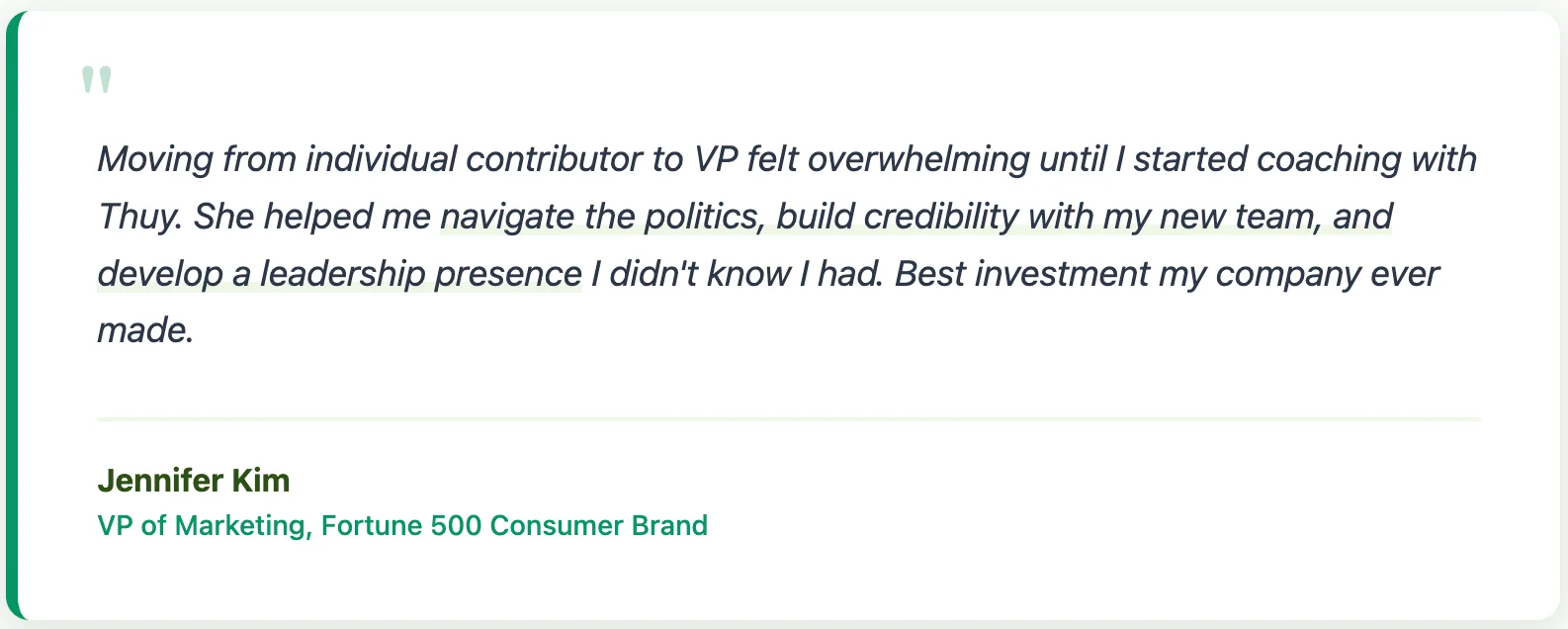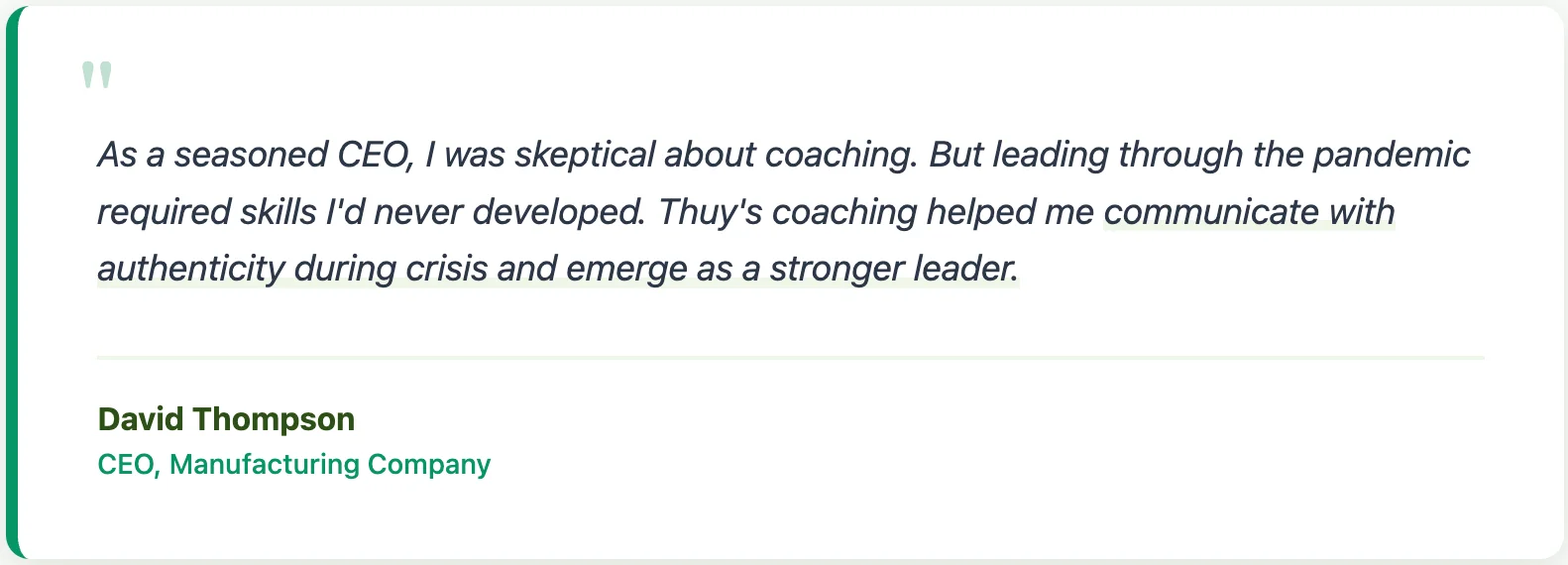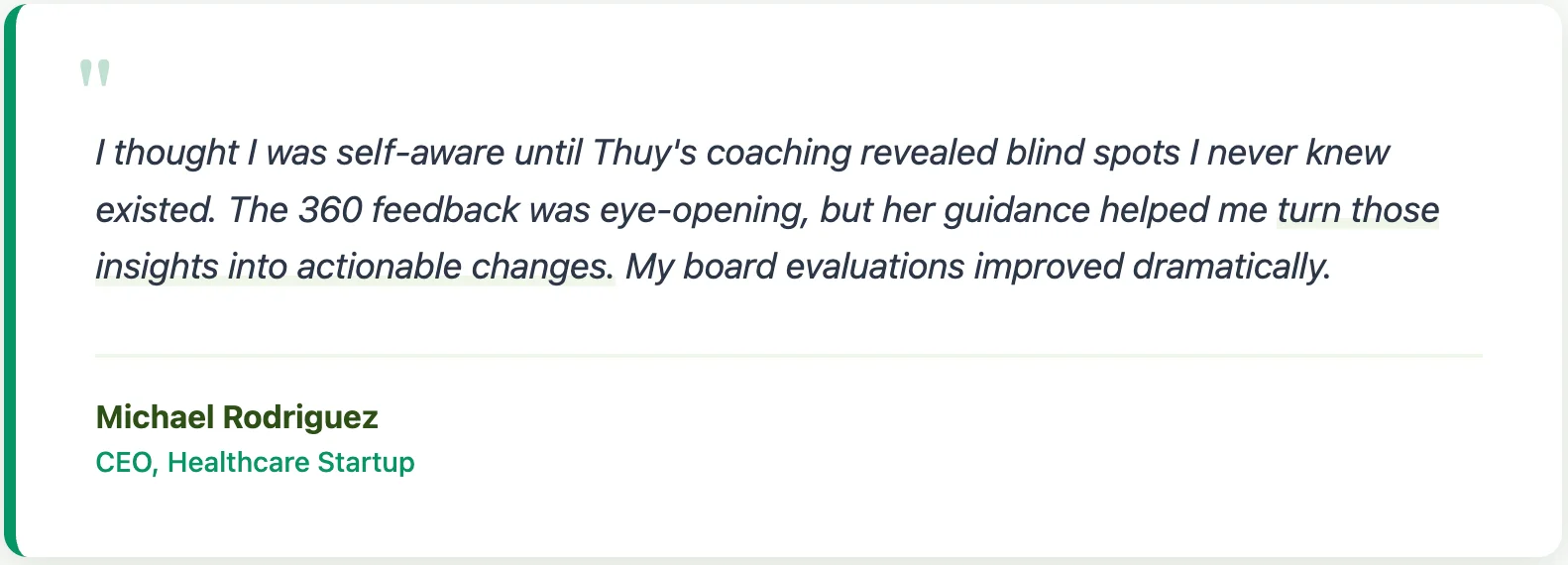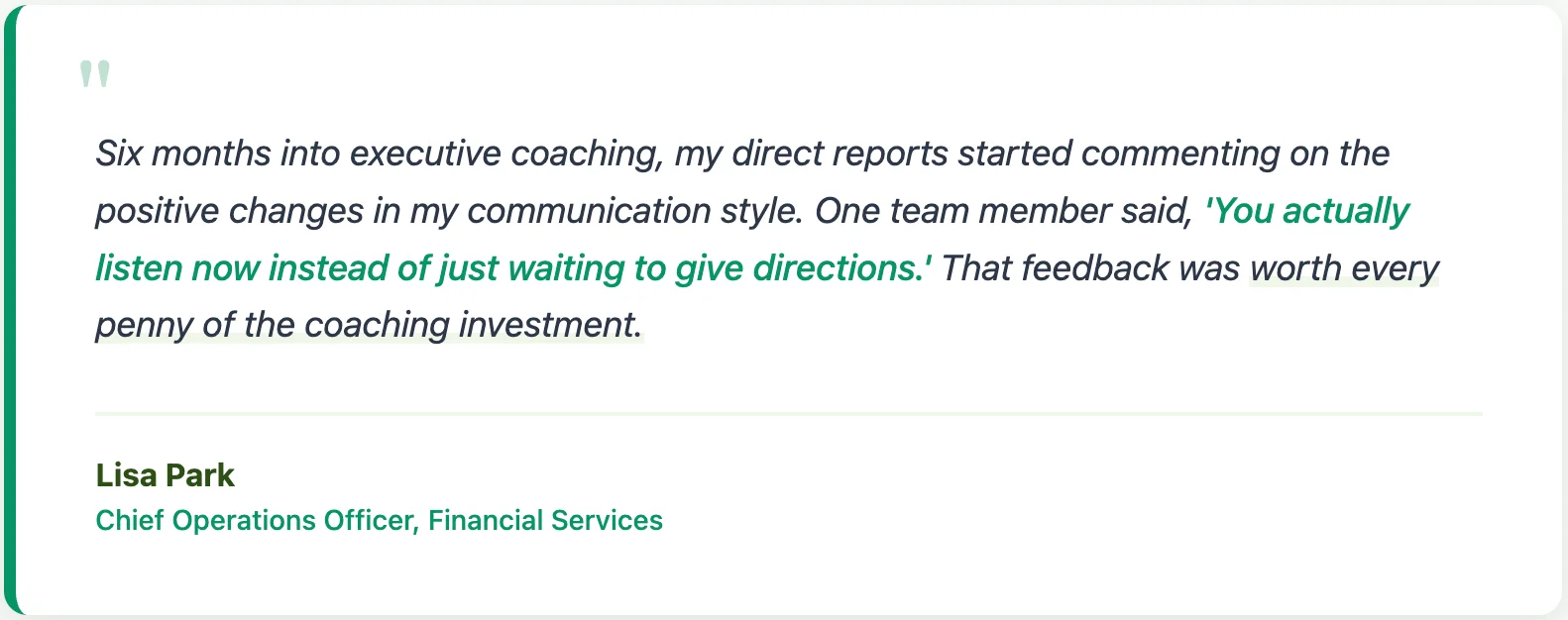What is executive coaching? Your complete guide for 2025 (by a 27-year veteran coach)
Key Takeaways
What is Executive Coaching?
Quick Answer
Executive coaching is a confidential, one-on-one professional development process that accelerates leadership effectiveness through structured conversations and skill-building exercises.
Who it’s for
Executive coaching is for high-potential employees preparing for leadership roles, Leaders transitioning into new positions or industries, seasoned executives facing unprecedented challenges, and leadership teams seeking better performance in alignment with organizational goals.
Duration
Executive coaching engagements typically last 6-12 months with bi-weekly sessions.
Expected ROI
The expected ROI of executive coaching is a 12-25% increase in team engagement and 15-30% improvement in retention rates.

After years of coaching executives, from startup CEOs to Fortune 5 C-suite leaders, I’ve learned that great leadership isn’t born, it’s built. In today’s rapidly evolving business world, even our most successful leaders require support to navigate new challenges.
I’ve coached leaders across every industry imaginable, from Apple and Google to Netflix and Uber, as well as biotech startups and entertainment giants. What I’ve found is that the fundamentals of good leadership remain the same, even as the business world continues to evolve.
What is Executive Coaching? A Clear Definition
Executive coaching is a confidential, one-on-one professional development process that accelerates leadership effectiveness through structured conversations and skill-building exercises.
In my experience building Skyline Group’s coaching practice (now managing over 180 coaches worldwide), I define executive coaching as distinct from other development approaches. It’s:
- Highly personalized to individual leadership challenges (not one-size-fits-all training)
- Action-oriented with real-time application in the workplace
- Confidential between coach and executive (creating safe space for growth)
- Results-focused on measurable business outcomes that impact specific business goals and the bottom line
What makes coaching uniquely powerful? It meets leaders where they are, with their actual challenges, in real-time. When a CEO at a major tech company told me, “I need to figure out how to have difficult conversations with my board,” we didn’t talk theory. We practiced the exact conversation she needed to have the following week.
The Four Core Leadership Domains in Executive Coaching
Through my doctoral research in organizational psychology and decades of coaching practice, I’ve identified that good executive coaching must address these key areas. We call it our competency-driven leadership development model:
- Leading Self - Self-awareness, emotional regulation, personal productivity
- Leading Others - Team building, communication, influence, and motivation
- Leading the Organization - Strategic thinking, culture building, change management
- Leading Implementation - Execution, accountability, performance management
These domains came from studying what separates high-performing leaders from their peers. In my book, “Hidden Strengths,” my co-author, Milo, and I detail how these competencies predict leadership success across various industries and organizational levels.

Who Needs Executive Coaching? (And Who Doesn’t)
Understanding the specific benefits of executive coaching helps organizations identify the right candidates and set appropriate expectations for their investment.
Prime Candidates for Executive Coaching
High-Potential Employees
Senior managers and emerging leaders identified for advancement require coaching to develop executive presence and strategic thinking prior to promotion.
New Role Transitions
Career Transitions Are Coaching Gold Mines. Leaders transitioning into unfamiliar territory—whether C-suite positions, international assignments, or cross-functional roles—benefit from targeted coaching during the critical first 90 days.

Seasoned Executives Facing New Challenges
This might surprise you, but some of my most engaged clients are successful executives. Even experienced leaders with strong business acumen encounter situations outside their comfort zone where they need critical support: digital transformation, crisis management, organizational transformation initiatives, etc.

”As a seasoned CEO, I was skeptical about coaching. But leading through the pandemic required skills I’d never developed. Thuy’s coaching helped me communicate with authenticity during crisis and emerge as a stronger leader.” -David Thompson, CEO, Manufacturing Company
Leadership Teams
Group coaching can align leadership teams around shared goals while addressing individual leaders’ personal growth and development needs.
When Executive Coaching May Not Be the Answer
I’ll be direct here. Coaching isn’t always the solution. In my experience, executive coaching fails when:
- Performance issues require disciplinary action - (coaching isn’t remedial training for misconduct)
- Leaders are unwilling to receive feedback - or change behaviors (I’ve had executives who thought they just needed validation)
- Organizations expect quick fixes - to deep cultural problems (coaching is development, not magic)
- Budget constraints prevent sustained engagement - (good coaching typically requires 6-12 months minimum)
I once had a potential client, a C-suite executive, who wanted coaching to “fix” their reputation after a public scandal. That’s not coaching. That’s crisis management. Coaching is effective when leaders are ready to grow, not when they’re seeking external validation or quick reputation repair.

The Executive Coaching Process: What to Expect
Phase 1: Assessment and Goal Setting (Weeks 1-3)
- 360-degree feedback assessment
- Stakeholder interviews with manager, peers, direct reports
- Leadership assessment tools and personality inventories
- Goal setting with clear objectives and development planning
Phase 2: Active Coaching (Months 2-9)
- Bi-weekly 60-90 minute coaching sessions
- Real-time problem-solving on current leadership challenges
- Skill practice and behavior modification
- Progress tracking and adjustment
Phase 3: Integration and Sustainability (Months 10-12)
- Reduced session frequency (monthly)
- Focus on sustaining new behaviors for lasting impact
- Final 360 assessment to measure progress
- Transition planning for continued development
Why Even Great Leaders Need Executive Coaching
This question comes up constantly. “Thuy, if someone’s already successful, why do they need coaching?”
Here’s what I tell them: Success can be its trap.
The Paradox of Success
In my years of coaching, I’ve observed that successful leaders often face unique challenges:
Breaking Successful Patterns That No Longer Serve
I worked with a CEO who’d built her company through hands-on leadership and personal relationships. It worked brilliantly when they had 50 employees. At 500 employees? Her style was strangling growth. The behaviors that made her successful as a founder were limiting her ability as a scale-stage CEO.
Maintaining Perspective Under Pressure
Senior roles involve complex decisions with incomplete information. Through a confidential relationship, I serve as a trusted advisor and sounding board for leaders making decisions that impact thousands of employees and millions of dollars in revenue. Sometimes they need someone to ask, “What aren’t you considering?” or “How does this align with your stated values?”
Avoiding the Echo Chamber Problem
The higher you climb, the less honest feedback you receive. External coaches fill this gap by providing unfiltered perspectives. I tell my clients: “Your direct reports aren’t going to tell you that your communication style is alienating the board.” That’s my job.
Developing Next-Generation Leaders
Great leaders multiply their impact by creating others. Through coaching, executives become better coaches themselves and create environments where leaders learn better. I’ve seen CEOs transform their entire organization’s culture by improving their coaching skills.
Through our Skyline 360 assessment tool, I’ve identified patterns in high-performer blind spots:
- Micromanagement tendencies - when delegating feels risky (especially common among technical leaders)
- Communication gaps - between vision and execution (what’s clear to you isn’t always clear to others)
- Burnout risk - from unsustainable work patterns (high performers often model unhealthy behaviors)
- Team dynamics - that successful individuals struggle to handle (being smart doesn’t automatically make you good at managing smart people)
I had one client, a brilliant VP of Engineering, who couldn’t understand why his team seemed disengaged. Through 360 feedback, we discovered that his rapid-fire communication style and tendency to jump to solutions were making his team feel undervalued.
Six months later, his team engagement scores had improved by 40%.

Executive Coaching vs. Other Development Methods
What Executive Coaching IS NOT
Executive coaching is often confused with other professional development approaches. Here’s how it differs:
Comparison of Developmental Support Methods

Not Mentoring
- Mentoring: Experienced professional shares wisdom and opens doors
- Coaching: Helps people discover their solutions through questioning
Not Consulting
- Consulting: Expert provides solutions and recommendations
- Coaching: Helps leaders develop their own solutions and decision-making capabilities
Not Training
- Training: Group learning of standardized content and skills
- Coaching: Individualized development based on specific leadership challenges, focused on individual growth.
Not Therapy
- Therapy: Addresses psychological issues and past trauma
- Coaching: Unlike career coaching, which primarily focuses on job transitions, executive leadership coaching addresses leadership skills and effectiveness.
Not a Magic Bullet
- Coaching requires active participation and a willingness to change
- Results depend on coach quality, leader commitment, and organizational support
Emotional Intelligence: The Executive Coaching Game-Changer
Why EQ Matters More Than Ever
Research consistently shows emotional intelligence accounts for 58% of job performance across all industries³. For executives, this percentage climbs even higher. Executive coaching is uniquely positioned to develop emotional intelligence because of its personalized, real-time approach.
According to the Center for Creative Leadership, the primary causes of executive derailment are deficits in emotional competence, with the three primary ones being difficulty in handling change, inability to work well in a team, and poor interpersonal relations⁴.
Self-Awareness Development
Coaching cultivates increased self-awareness in leaders, enabling them to develop deep understanding of their emotional triggers and response patterns that derail performance.
Self-Regulation Under Pressure
Techniques like mindfulness, reframing, and stress management prevent impulsive decisions during crises.
Better Empathy
Role-playing and perspective-taking exercises improve leaders’ ability to connect with diverse team members.
Social Skills Mastery
Improving communication, conflict resolution, and strategic influence skills to become more sophisticated through coaching practice.

The Neuroscience of Leadership Coaching
Brain research reveals the critical role coaches play in rewiring neural pathways:
- Increased prefrontal cortex activity: Improves executive function
- Reduced amygdala reactivity: Leads to better emotional control
- Better neuroplasticity: Accelerates learning and adaptation

How Much Does Executive Coaching Cost? Investment Reality Check
The costs of executive coaching is one the most frequently asked questions I receive.
Pricing Factors That Drive Executive Coaching Costs
After building a global coaching practice, here’s what drives pricing. Executive coaching costs vary based on:
- Level of the leader and job title
- Length of engagement
- Number and type of assessments performed, and other variables
Executive coaching as a strategic investment. Like any bespoke service, pricing is commensurate with the level of service, the quality, and results.
What is unique about Skyline G’s offering is that we can measure the ROI of your coaching investment.
Red Flags in Coaching Pricing
Based on my experience, avoid coaches who:
- Won’t discuss track record and specific methodologies (transparency matters)
- Require upfront payment without clear deliverables (legitimate coaches offer payment plans)
- Promise guaranteed outcomes (ethical coaches focus on process, not promises)
- Price significantly below market (often indicates limited coaching experience. You get what you pay for)
- Lack of measurement and accountability systems (how will you know if it’s working?)
Finding the right executive coach requires investment. I’ve seen too many organizations burned by cheap coaching that delivered no results. Investing in quality coaching is expensive. Poor coaching is even more costly when you factor in opportunity costs.
FAQ
Can executive coaching be done virtually?
Yes, virtual coaching has proven highly successful, especially since the pandemic. Many executive coaches report that virtual sessions can be more focused and efficient than in-person meetings.
How do I know if executive coaching is working?
Look for specific behavior changes within 2-3 months, improvements in feedback from stakeholders, and progress toward the stated goals. If you’re not seeing measurable progress by month 4, reassess the coaching approach. You should work with a firm that can measure the impact and ROI of the investment.
How do I find qualified executive coaches?
Look for a skilled executive coach with relevant industry experience. Get professional referrals, web search, and interview at least three professional coaches and firms. Always interview multiple executive coaches and check references before making a decision - experience in your industry is an essential factor.
Real Client Impact

After many years in executive leadership coaching, I’ve learned that the best senior leaders never stop learning.
Executive coaching isn’t a sign of weakness. It’s a competitive advantage. Whether you’re a first-time manager or a seasoned CEO, the right coaching relationship can accelerate your impact and transform your leadership ability, and drive organizational success.
If you’re considering coaching for yourself or your organization, remember: it’s not about fixing what’s wrong. It’s about unleashing what’s possible.

Ready to Elevate Your Leadership Journey? Take the First Step Today
Executive coaching isn’t about fixing weaknesses - it’s about unlocking your full potential as a leader.
Whether you’re a startup founder, an executive navigating challenges like team alignment and strategic transitions, or an HR professional developing your organization’s leaders, now is the time to invest in personalized growth that delivers immediate impact on leadership effectiveness and measurable ROI.
Schedule a Complimentary 30-Minute Discovery Session with Skyline G
Let’s discuss your unique leadership goals and development opportunities - whether for yourself or your team - and discover how Skyline Group’s external perspective, proven methodology, and global network of 180 coaches can accelerate your success. With 20+ years of supporting clients and delivering success stories, our executive coaching services have helped Apple, Google, Netflix, Uber, and hundreds of other organizations achieve leadership excellence.
Book Your Complimentary 30-Minute Discovery Session Now or email us at [email protected]
References
¹ International Coach Federation (International Coaching Federation). “2020 ICF Global Coaching Study.” ICF, 2020. https://coachingfederation.org/research/global-coaching-study
² PwC. “Building Leadership Bench Strength: Planning for an Uncertain Future.” PwC, 2021.
https://www.pwc.com/jp/en/advisory/industry-fs/bcm/assets/pdf/future-leadership-development.pdf
https://www.strategyand.pwc.com/gx/en/insights/archive/global-talent-innovation/strategyand-global-talent-innovation.pdf
³ Bradberry, T. & Greaves, J. “Emotional Intelligence 2.0.” TalentSmart, 2009. https://www.talentsmarteq.com/products/emotional-intelligence-2.0/
⁴ Center for Creative Leadership. “The Lessons of Experience: How Successful Executives Develop on the Job.” Lexington Books, 1988.
https://shop.ccl.org/usa/the-lessons-of-experience-how-successful-executives-develop-on-the-job.html
https://www.ccl.org/articles/leading-effectively-articles/15-experiences-that-help-you-learn-to-lead/
⁵ Gallup. “State of the Global Workplace.” Gallup Press, 2022. https://www.gallup.com/workplace/349484/state-of-the-global-workplace.aspx















